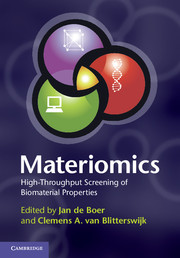Book contents
- Frontmatter
- Contents
- List of contributors
- Preface
- Chapter 1 Introducing materiomics
- Chapter 2 Physico-chemical material properties and analysis techniques relevant in high-throughput biomaterials research
- Chapter 3 Materiomics using synthetic materials: metals, cements, covalent polymers and supramolecular systems
- Chapter 4 Microfabrication techniques in materiomics
- Chapter 5 Bioassay development
- Chapter 6 High-content imaging
- Chapter 7 Computational analysis of high-throughput material screens
- Chapter 8 Upscaling of high-throughput material platforms in two and three dimensions
- Chapter 9 Development of materials for regenerative medicine: from clinical need to clinical application
- Chapter 10 Non-biomedical applications of materiomics
- Chapter 11 Beyond bed and bench
- Index
- References
Chapter 9 - Development of materials for regenerative medicine: from clinical need to clinical application
Published online by Cambridge University Press: 05 April 2013
- Frontmatter
- Contents
- List of contributors
- Preface
- Chapter 1 Introducing materiomics
- Chapter 2 Physico-chemical material properties and analysis techniques relevant in high-throughput biomaterials research
- Chapter 3 Materiomics using synthetic materials: metals, cements, covalent polymers and supramolecular systems
- Chapter 4 Microfabrication techniques in materiomics
- Chapter 5 Bioassay development
- Chapter 6 High-content imaging
- Chapter 7 Computational analysis of high-throughput material screens
- Chapter 8 Upscaling of high-throughput material platforms in two and three dimensions
- Chapter 9 Development of materials for regenerative medicine: from clinical need to clinical application
- Chapter 10 Non-biomedical applications of materiomics
- Chapter 11 Beyond bed and bench
- Index
- References
Summary
Scope
Given the demographic challenges of an ageing population combined with rising patient expectation and the growing emphasis placed on cost containment by healthcare providers, economic regenerative medicine approaches for regeneration of damaged and diseased organs and tissues are a major clinical and socio-economic need. The scope of this chapter is to use skeletal regeneration as the exemplar to discuss classical and high-throughput screening approaches to biomaterials development for regenerative medicine, including choice and design of materials based on clinical need, biological assessment and regulatory issues.
Basic principles: development of materials for regenerative medicine
The increase in an ageing population in developed countries is accompanied by a growing need for replacement and repair of damaged organs and tissues. Transplantation of the patient’s own tissue is still considered the gold standard in many applications, but limited availability, and complications associated with harvesting of the so-called autograft, are becoming an important drawback. Tissues and organs from human or animal donors present issues of disease transmission and functional failure. Alternative strategies, based on biological growth factors, cell therapy and tissue-engineered constructs, are being explored as alternatives to the patient’s own tissue, but their use is hampered by biological instability and high costs. These issues demonstrate the need for strategies based on biomaterials, which are often synthetic, and thus less prone to instability problems. In addition, the fact that (synthetic) biomaterials can often be produced in large quantities and thus be available off-the-shelf is an important advantage when coping with an increasing need for regenerative approaches.
- Type
- Chapter
- Information
- MateriomicsHigh-Throughput Screening of Biomaterial Properties, pp. 155 - 176Publisher: Cambridge University PressPrint publication year: 2013
References
- 1
- Cited by



